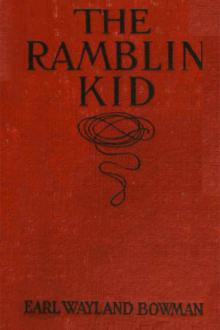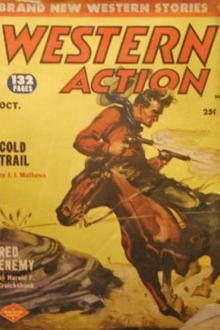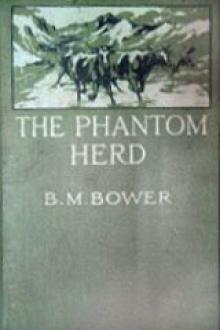Spinifex and Sand<br />A Narrative of Five Years' Pioneering and Exploration in Western Ausralia, David Wynford Carnegie [best novels in english .txt] 📗

- Author: David Wynford Carnegie
Book online «Spinifex and Sand<br />A Narrative of Five Years' Pioneering and Exploration in Western Ausralia, David Wynford Carnegie [best novels in english .txt] 📗». Author David Wynford Carnegie
On nearing the lakes the creek assumes so dismal an appearance, and so funereal is the aspect of the dead scrub and dark tops of the “boree” (a kind of mulga), that one wonders that Gregory did not choose the name of “Dead” instead of merely “Salt Sea.” A curious point about this lower part of the creek is, that stretches of fresh and salt water alternate. The stream, as we saw it, was only just running in the lower reaches; in places it ran under the sandy bed, and in this part the salt pools occurred. First we passed a stretch of clear, brackish water, then a nearly dry reach of sand, then a trickle of fresh water lasting for a hundred yards or so; this would again disappear, and be seen lower down as another salt pool.
The creek enters the first lake in a broad estuary; this lake is some four miles long by two miles wide, lying North and South. At the southern end a narrow channel, 150 yards wide, winds its way into the large lake beyond, a fine sheet of water, eight miles in diameter. A narrow belt of open country, overgrown with succulent herbage, fringes the margin of the lake; beyond it is dense scrub, with occasional patches of grass; beyond that, sand, sandhills, and spinifex. In the distance can be seen flat-topped hills and bluffs, and rising ground which encloses the hollow of the lake. The lake has no outlet; of this Gregory satisfied himself by making a complete circuit of it. At the time of his discovery the lakes were dry, or nearly so, and doubtless had the appearance of being shallow depressions, such as the salt lakes in the southern part of the Colony; so that having followed the Sturt for so many miles—a creek which showed every appearance of occasionally flooding to a width of five or six miles—he must have been somewhat uncertain as to what happened to so great a volume of water. However, the lake is nearly thirty feet deep in the middle, and, from its area, is capable of holding a vast amount of water. The creek, below its confluence with the Wolf, is continually losing its waters, throwing off arms and billabongs, especially to the west, which form swamps, clay-pans, and lagoons. So much water is wasted in this manner that near the entrance into the lake the creek is of a most insignificant size. The fall, too, is so gradual that the water runs sluggishly and has time to soak away into the enclosing sand.
Mr. Stretch tells me that it takes eight days for the water from rain falling at the head of the Sturt to pass his homestead, which gives it a rate of one mile per hour. Heavy rains had fallen at its source about a month before our arrival, and the water was still flowing. We therefore saw the lakes as full as they are ever likely to be, except in abnormal seasons. North of the lake are numerous large clay-pans which had not been flooded, and the lakes could evidently hold more water, and had done so in time past, so that it is pretty clear that the lakes are large enough for ordinary flood waters, and, with the outlying clay-pans, can accommodate the waters of an extraordinary flood.
I feel confident, therefore, that no outlet exists, and that beyond doubt the Sturt ends at the Salt Sea, and does not “make” again further South, as some have suggested. Standing on any of the hills which surround the lake, some distance (ten miles or so) from it, one can look down upon the water, certainly five hundred feet below the level of the hills, which rise no more than eighty feet above the surrounding plain. It seems most improbable, therefore, that a creek should break its way through country of so much greater altitude without being seen by Colonel Warburton or myself, or that any connection should exist between the Salt Sea and Warburton's Salt Lakes to the South-East.
Had, however, the intervening country been of the same level as the lake, and flat instead of formed into high sand ridges and hills, there might have been a possibility of crossing a connecting creek of the same character as the Sturt without noticing it. This question has been much discussed by gentlemen interested in the geography of interior Australia, and therefore I have dealt with it at some length.
CHAPTER III Our Camp On The “Salt Sea”April 2nd to 7th we were the guests of Mr. Stretch, and whilst resting here Godfrey's eyes soon became well enough to allow him to travel. On the 7th, therefore, we set forth on our journey and bade adieu to the last outpost of civilisation in the North. Our party was further increased by a Sturt Creek boy, Tiger by name—a very smart and intelligent fellow of whom Mr. Stretch was very glad to see the last, for smart boys are nearly always the most mischievous amongst the cattle. Warri and Tiger were great friends, and the new boy's presence put Warri on his mettle, and no amount of work was too hard for him whilst he had Tiger to show off to. After I had cut his hair and shampooed his head with kerosene and soap, dressed him in trousers, shirt, and cap, he looked a most presentable youth.
Mr. Stretch accompanied us down the creek for the first few days, during which we passed some of his cattle and horses. The flies and mosquitoes worry the poor beasts terribly, and all day long the horses stand in the water in pairs, or in a line, with head to tail, each one flicking the flies from his neighbour's face with his tail. This habit of standing up to the girth in water has given rise to a horse sickness known as “swamp-cancer.” The skin under the belly becomes so soft that at last a raw place is formed, and this, aggravated by the flies, spreads until it becomes a serious disease. Another horse-sickness common in the North is called the “Puffs.” A horse suffering from this pants and blows after the least exertion, and in the hot weather his skin becomes puffy, and any violent exercise would be fatal. The Monk, one of our horses, suffered from this slightly; as soon, however, as we had left the Kimberley district and entered the desert he recovered entirely. Numerous small families of natives were camped along the creek, all accompanied by dogs, which gave us some annoyance at night; for salt meat, at first, should be hung out during the night to get the benefit of the fresh air, and this roused their hungry instincts. A few miles below the Wolf, Mr. Stretch left us, and we parted from our kind host with regret—he to return to his cattle, and we to the task of laying bare the richness (we hoped) or the nakedness (we expected) of the untrodden land before us.
At first we did very small stages, for the joy of travelling alongside running water was too great to be quickly passed over. The camels and horses became good chums very soon, and played about together without any signs of fear or surprise on the part of the horses, although they had never seen camels before—a different state of affairs from that in Coolgardie, where horses as a rule snort and plunge with terror on first acquaintance with an “emu-brother,” as the black-fellow calls the camel. As we neared the lakes we had some difficulty in finding water fit to drink, and camped about nine miles above the lakes, whilst Godfrey and I scouted ahead to see if fresh water could be found lower down. We surprised two camps of natives, most of whom ran into the scrub as we approached—several gins and a boy remaining. One of the women had a most remarkable baby, quite a small thing, but with a tremendous growth of black hair, shiny and straight, altogether different from the ordinary coarse hair of the aboriginal. They came with us, walking beside us as we rode, jabbering and gesticulating in their usual excited manner, and inviting us to their camp, pointing to the rising smoke. Water, however, was our requirement, so we continued on our way down the creek, the boy coming with us. We shot a few ducks which our young friend retrieved, and having found a reach of fresh water just above the first and smaller lake, returned campwards, surprising a hunting-party on our way; they retired quickly, the boy following them, taking with him the ducks which we had been at such pains to stalk!
Illustration 43: A wild escort of nearly one hundred men
The next day we moved camp to the fresh-water reach, and had not been travelling long before a small tribe of blacks came round us, quickly followed by our friends of the day before, and presently by more, until we were marching along with a wild escort of nearly a hundred, mostly men; they were fearfully excited, though quite friendly, and with yells and shouts danced alongside, waving their spears and other weapons. I never heard such a babel, or saw such frantic excitement about nothing, or at least nothing that we could understand. Their wildness was tempered with some fear of the camels, though with the horses they were quite familiar, even going so far as to hit poor old Highlander, that I was riding, on the rump with their spears, a proceeding that he did not approve of. “Womany,” “Womany,” “White-fella,” “Womany,” “White-fella,” they kept on shouting; if they meant to call our attention to the beauties of their gins they might well have spared themselves the trouble, for a more hideous lot of females I never set eyes on. Presently another wild yell heralded the approach of a large band of “womany” who waded breast deep across the creek, followed by their dogs swimming behind. These were no improvement on the first lot; all the old and ugly ladies of the neighbouring tribes must have been gathered together. Their dogs however, were worthy of notice, for they were Manx-dogs, if such a word may be coined! Closer inspection showed that they were not as nature made them. For the tails of the dingoes the Government pays five shillings apiece; as their destructive habits amongst sheep make them better liked dead than alive. A black fellow's dog is much the same as a dingo—in fact must have descended from the wild dog—and has the same value in his owner's eyes with or without a tail. A stick of tobacco is fair payment for a dog's tail. Thus all parties are satisfied except the dog; and the Government is content to pay, not dreaming that “dog-stiffeners” (i.e., men who make a living by poisoning dingoes) carry on so base a trade as bartering tobacco for live dogs' tails!
Our cavalcade still further increased by women and dogs, we proceeded on our way, until choosing a high sandy bank overlooking the estuary of the small lake on the South, the creek to the North-West, and a backwater to the North, we halted and prepared to make camp. This was attended by some difficulty, for our native friends, now in considerable numbers, evidently wished to look upon it as their camp too. They soon became so tiresome that I had to tell them through Tiger, as interpreter, that unless they retired forthwith and kept to the other side of the creek, we should take strong measures to remove them. Before long they had all done as they were bid, and made their camp about a mile away across the water—and the bulk of them we did not see again. Small parties were continually visiting us, and we were the best of friends.
Our camp was in lat. 20° 11´ long. 127° 31´, and here we stayed five days to give our stock a final rest, and regale on luscious food and abundant water, before tackling the dreary country that we knew to be before us. For our own sakes we were by no means keen on leaving this delightful spot; the very thought of those sand-ridges seemed to make one's heart sink to one's boots! Our camp consisted of a bough-shade, and mosquito-nets, of course. Barring





Comments (0)